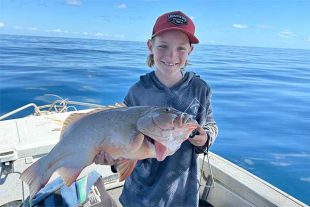Back on October 14-16, the 2022 Queensland freshwater workshop took place in Mackay.
A printout of the proceedings was released to the fish-stocking groups.
This workshop is of interest to all freshwater anglers, not only fish-stocking groups.
I feel that this 12-page report should be obtainable by anglers either by post or by Fisheries Queensland on its website, to get a full picture of the outcomes.
Keeping in mind that we now have a two-year wait until the next workshop to see if any outcomes from this meeting have been actioned.

It’s a long time between drinks and we, as anglers, need to be able to voice concerns on any arrangements that are to take place.
Stocking groups are working as hard as possible to maintain stocking levels within storages.
River stocking is taking a lot of hard work to manage anglers’ requirements on these systems.
These small fish restocking groups feel as though they are behind the eight ball when it comes to funding and stocking native fish – be it east or west of the Great Divide.
Garry Fitzgerald spoke of this problem during the workshop, and the cost of the permit is a major issue, as well as the return we all get from it.
Someone stated that yellowbelly and silver perch don’t breed in dams – this could be quite true – and that they breed in rivers and streams is correct.

So, let’s look at Glenlyon Dam which is 35km long when at full-supply limit.
Above that level, it is water from Pike Creek that feeds into the storage.
Given the right water surface temperature of 22-24C and a good flow-in exists, yellowbelly and silver perch will head up that source to breed.
The eggs will be laid and fertilisation will take place.
In most cases, these two species will move upstream as far as they can go – for example, 36km upstream at Foxbar Falls is a barrier they cannot get over.
The eggs are a mass that sticks to twigs, grass and other floating items heading back downstream to… you guessed it… Glenlyon Dam, to live out their lives, if not caught.

So, if the minimum 30cm take home is changed to 35cm, essentially another 12 months is added to the life of the fish, also the possibility of having another two years of breeding out of that fish.
In a different context, by increasing the size limit to 35cm for both silver and golden perch in both rivers and dams, you’re getting a larger fish fillet to eat and enjoy.
Though note the no take of silver perch in rivers.
The above equation has taken place above and below Glenlyon Dam, as sighted by storage staff below the outlet valve, which is a fish barrier below the dam wall.
A slow down of water flow in the streams around the district is at last giving us a chance to fish our river haunts.
The result of about 12 months of above-average river flows has changed many previous good fishing holes, making way for new locations to fish.

Be advised, watch out for logs and deep drop-offs – if not sure as to how you will either go up or down these locations, get out and walk it.
The new lease of life resulting from the flow in the rivers is good news for all.
Our local river people on farms stated that they have never seen it better, with the recruitment of all fish species large and small – including shrimp, crayfish and such.
Our once non-flowing rivers in 2019-2021 have been given a new life and a fresh start is in place.
The crunch line to all of the above will be how well the water is to be actually managed by those in charge – the next four years will reveal how the Murray Darling survives.
In closing, contact the Department of Agriculture and Fisheries, ask for a copy of the 2022 Queensland freshwater stocking workshop proceedings report either by post or the website.
This 12-page document is important to all freshwater recreational anglers in Queensland, so that we can see the last three pages of items being worked on.
 Bush ‘n Beach Fishing Magazine Location reports & tips for fishing, boating, camping, kayaking, 4WDing in Queensland and Northern NSW
Bush ‘n Beach Fishing Magazine Location reports & tips for fishing, boating, camping, kayaking, 4WDing in Queensland and Northern NSW










